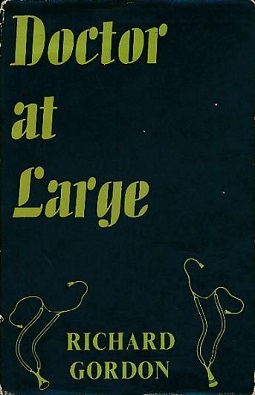Doctor at Large (novel)
Doctor at Large is a novel written by British author Richard Gordon, which was first published in 1955. It is part of the Doctor series of books that humorously explore the life and times of the medical profession, specifically focusing on the experiences of a young doctor named Dr. Nicholas (Nick) Ouranios, commonly referred to as Dr. Nick. The novel follows the protagonist as he navigates through various placements in the medical field, encountering a variety of patients, colleagues, and situations that highlight the absurdities and challenges of the medical profession.
Plot Summary[edit | edit source]
Doctor at Large continues the adventures of Dr. Nick as he moves on from being a junior doctor at St. Swithin's Hospital to explore different aspects of the medical profession. After passing his exams, Dr. Nick finds himself traversing the country, taking on various jobs that range from general practice to research and even a stint in the pharmaceutical industry. Each new position brings its own set of unique challenges and comedic situations, often highlighting the gap between the idealism taught in medical school and the reality of practicing medicine. Through his journey, Dr. Nick gains a deeper understanding of his own capabilities and the type of doctor he wants to become.
Characters[edit | edit source]
- Dr. Nicholas Ouranios (Dr. Nick) - The protagonist, a young and somewhat naive doctor, eager to find his place in the medical world.
- Sir Lancelot Spratt - A formidable and eccentric consultant at St. Swithin's Hospital, known for his booming voice and intimidating presence. He occasionally crosses paths with Dr. Nick, offering both challenges and guidance.
- Dr. Tony Benskin - A fellow doctor and friend of Dr. Nick, known for his laid-back attitude and penchant for getting into humorous predicaments.
- Dr. Richard Grimsdyke - Another colleague and friend of Dr. Nick, characterized by his wit and clever schemes to navigate the complexities of hospital politics and patient care.
Themes[edit | edit source]
The novel explores several themes relevant to the medical profession and society at large. One prominent theme is the transition from academic knowledge to practical application, as Dr. Nick and his colleagues learn to apply their medical training to real-world situations. The book also delves into the idea of professional identity, as the protagonist seeks to understand what kind of doctor he wants to be. Additionally, Doctor at Large addresses the challenges of the healthcare system, including bureaucracy, the doctor-patient relationship, and the ethics of medical practice.
Reception[edit | edit source]
Doctor at Large was well-received upon its publication, praised for its humor, insightful observations of the medical profession, and the development of its protagonist. The novel's blend of comedy and commentary on the state of healthcare has made it a favorite among both medical professionals and the general public. It has been adapted into various formats, including a successful television series, further cementing its place in British popular culture.
Adaptations[edit | edit source]
The popularity of Doctor at Large led to its adaptation into a British television series of the same name, which aired in 1971. The series expanded on the characters and situations from the novel, bringing the humorous and sometimes poignant adventures of Dr. Nick and his colleagues to a wider audience.
See Also[edit | edit source]
This article is a literature-related stub. You can help WikiMD by expanding it!
Search WikiMD
Ad.Tired of being Overweight? Try W8MD's physician weight loss program.
Semaglutide (Ozempic / Wegovy and Tirzepatide (Mounjaro / Zepbound) available.
Advertise on WikiMD
|
WikiMD's Wellness Encyclopedia |
| Let Food Be Thy Medicine Medicine Thy Food - Hippocrates |
Translate this page: - East Asian
中文,
日本,
한국어,
South Asian
हिन्दी,
தமிழ்,
తెలుగు,
Urdu,
ಕನ್ನಡ,
Southeast Asian
Indonesian,
Vietnamese,
Thai,
မြန်မာဘာသာ,
বাংলা
European
español,
Deutsch,
français,
Greek,
português do Brasil,
polski,
română,
русский,
Nederlands,
norsk,
svenska,
suomi,
Italian
Middle Eastern & African
عربى,
Turkish,
Persian,
Hebrew,
Afrikaans,
isiZulu,
Kiswahili,
Other
Bulgarian,
Hungarian,
Czech,
Swedish,
മലയാളം,
मराठी,
ਪੰਜਾਬੀ,
ગુજરાતી,
Portuguese,
Ukrainian
Medical Disclaimer: WikiMD is not a substitute for professional medical advice. The information on WikiMD is provided as an information resource only, may be incorrect, outdated or misleading, and is not to be used or relied on for any diagnostic or treatment purposes. Please consult your health care provider before making any healthcare decisions or for guidance about a specific medical condition. WikiMD expressly disclaims responsibility, and shall have no liability, for any damages, loss, injury, or liability whatsoever suffered as a result of your reliance on the information contained in this site. By visiting this site you agree to the foregoing terms and conditions, which may from time to time be changed or supplemented by WikiMD. If you do not agree to the foregoing terms and conditions, you should not enter or use this site. See full disclaimer.
Credits:Most images are courtesy of Wikimedia commons, and templates Wikipedia, licensed under CC BY SA or similar.
Contributors: Prab R. Tumpati, MD

